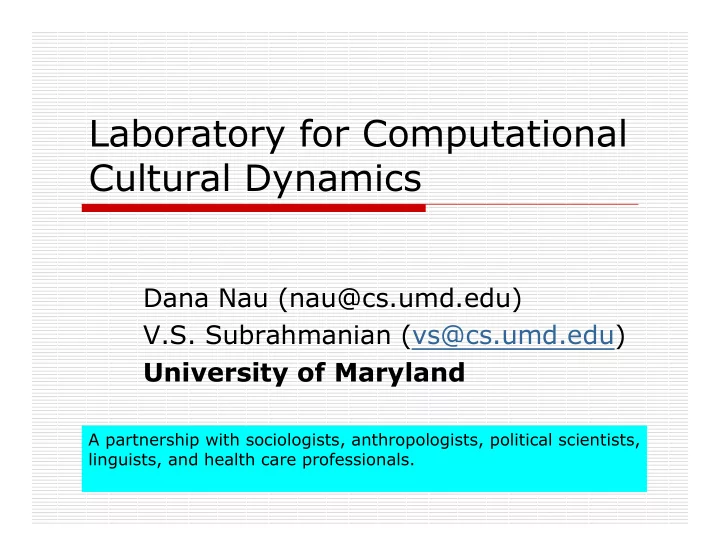

Laboratory for Computational Cultural Dynamics Dana Nau (nau@cs.umd.edu) V.S. Subrahmanian (vs@cs.umd.edu) University of Maryland A partnership with sociologists, anthropologists, political scientists, linguists, and health care professionals.
Today’s Motivation focus Reasoning about cultures is critical for multiple applications: War/Counter-Terrorism: how can we get different tribes/groups in a region to do what we’d like them to do? Global Health: how do social/cultural behaviors contribute to the spread of infectious diseases? Post-Conflict Reconstruction: how can we set up an infrastructure in a country that has gone through a period of internal (or other) war? All of these factors affect us.
LCCD Today’s focus Overall goal is to develop the computational infrastructure needed to help others Wage effective war/counterterrorism operations Ensure socio-economic-political change in foreign countries E.g. Social security reform in foreign countries Help reconstruct post-conflict or post-disaster societies.
LCCD Work with AFOSR AFOSR provides core Cultural Advisory Board funding for LCCD. Current Deputy Minister of the Interior of Basic theoretical Afghanistan foundation to build Former Pakistan applications that reason Ambassador to UK about different cultures A well known film- (to some extent). maker about Software platform based Afghanistan tribes on the above theory for Former State Dept. application development. offical stationed in Instantiate the above Pakistan theory and system with a + Other well known cultural context for the authors about Pakistan/Afghanistan Pak/Afghan tribes borderlands.
LCCD Architecture (parts) Agent-based simulation model M I D Prediction and Computational - Evaluation Behavioral W Algorithms Models A R e Cultural Predict possibilities Likelihood Rules Contextual DBs Assess possibilities Utility Functions Demographic Find best response (or Goals Economic Good enough) Political News sources ETC.
Cultural Contextual Database Set of DBs about background information on a given culture. Characteristics about data/problem Comes from multiple sources: need to track pedigree. Pedigree/reliability algebra. Inconsistency and Uncertainty are omnipresent. Draw inferences in the presence of incomplete and uncertain information. Algebra/calculus to integrate information from multiple incomplete/inconsistent data sources. Data is obtained from heterogeneous sources. Even accessing these can be a challenge. Assessing tone/opinion of select sources (e.g. news sources) can be an indicator. Users need data in English, not SQL.
Cultural Contextual DB Work Underway UMD’s PAT-DB (Pakistan-Afghanistan Tribes DB) is well under construction. Names People Tribes Locations Historical information Alliances, etc.
Provenance wrappers/reliability ontology Example qualitative levels Each data source has a provenance wrapper. Function χ (s,o) that specifies likely for a given object o and source s, the reliability of the information in object o according to source s. Output can either be on a neutral qualitative scale or a quantitative scale. Algorithms to go from qualitative to quantitative and vice versa. Algorithms to learn and revise reliability periodically. unlikely Reliability ontology associates reliabilities with sources, subsources, etc. Very unlikely
Computational Behavior Models Consists of three components Qualitative deontic likelihood rules . Utility functions. Goals. Identify a set of plausible things that a decision maker might do that satisfy the rules and progress towards the goal as measured by the objective function. Builds on our past work on the IMPACT heterogeneous agent system (4 papers on this in AIJ since 1999, plus several others).
Qualitative Likelihood Rules Action atom a: p(X1,…,Xn) Expression of the form OP a where OP is one of: P – permitted F – forbidden O – obligatory DO – does W – obligation is waived Rules: a IF <cond. on CC-DBs> & conjunction of action atoms. Likelihood rules: Replace “a” by “a:l” where l is a likelihood level. FOR OUR O.R. FRIENDS: Likelihood rules are like constraints.
Utility Functions Express the utility of certain actions in a given situation. Triple: Condition C Action atom A Numeric Formula F F returns the value of doing A in a situation satisfying condition C. E.g. C=tribal leader threatened with execution A=any action that preserves honor of tribe V=some high number
Goal-Utility-Triples Specify the value V of achieving goal G if the situation satisfies condition C. E.g. G = save-tribal-leader C = difference between terror group strength and tribal strength exceeds some bound. V = some value
Recent work Developed algorithms to find a set S of actions that optimize any given objective function and satisfy a set of deontic rules (without likelihoods). Also fast heuristic algorithms to find suboptimal solutions. Stroe, Subrahmanian, Dasgupta - AAMAS 2005 best paper award nominee. (4 nominees of ~530 papers). Extended this when rules include time and uncertainty. Dix, Kraus, Subrahmanian – ACM Trans. On Computational Logic (to appear 2005). Builds on temporal probabilistic DB models Dekhtyar, Ross, Subrahmanian – ACM-TODS 2001 Biazzo, et. Al. – IEEE-TKDE 2004. Ross, Subrahmanian, Grant – J.ACM 2005
Prediction and Evaluation Algorithms We can also view this Search space can be as a game tree enormous. Strategies we problem where propose to follows: Nodes represent Strategy based game situations trees. (Smith, Nau et.al. win World Computer Edges represent Bridge Comp. 1997) moves that either we or an opponent can Abstraction and make. decomposition Statistical simulation based on random hypotheses (of what the enemy might do) Planning under uncertainty
Spatio-Temporal Prediction Joint with NRL, BBN, Lockheed and many others as part of the DARPA Co-ABS program. Predict when and where enemy submarines will be in the future. Similar system for vehicle prediction with the Army. (video available).
Conclusions LCCD Director: Dana Nau Associate Director: Antonio Carvalho. Contact info: Univ. of Maryland Institute for Advanced Computer Studies, AV Williams Building, College Park, MD 20742. Tel: (301) 405-6722. Email: vs@cs.umd.edu
Recommend
More recommend